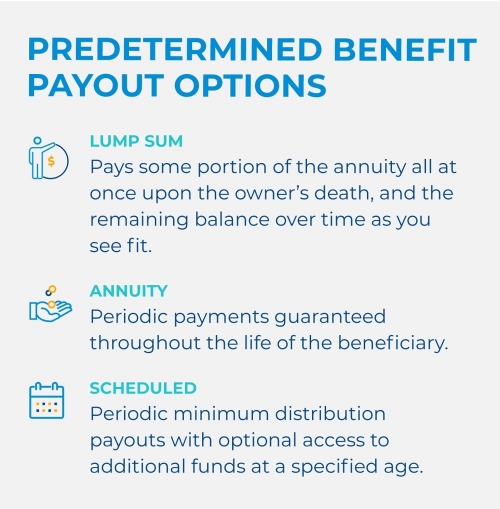All Categories
Featured
Table of Contents
This five-year basic guideline and two following exceptions use just when the proprietor's death causes the payout. Annuitant-driven payouts are talked about below. The very first exemption to the general five-year regulation for specific recipients is to approve the survivor benefit over a longer period, not to surpass the anticipated life time of the beneficiary.
If the beneficiary elects to take the survivor benefit in this technique, the benefits are exhausted like any various other annuity repayments: partly as tax-free return of principal and partially taxable earnings. The exclusion ratio is located by utilizing the departed contractholder's expense basis and the expected payments based upon the recipient's life span (of shorter duration, if that is what the recipient chooses).
In this method, often called a "stretch annuity", the recipient takes a withdrawal annually-- the needed quantity of each year's withdrawal is based on the very same tables made use of to calculate the needed distributions from an individual retirement account. There are 2 advantages to this method. One, the account is not annuitized so the beneficiary preserves control over the money value in the agreement.
The second exemption to the five-year guideline is offered only to an enduring spouse. If the marked recipient is the contractholder's spouse, the spouse may elect to "enter the footwear" of the decedent. Basically, the spouse is dealt with as if he or she were the proprietor of the annuity from its inception.
Tax treatment of inherited Annuity Death Benefits
Please note this uses just if the partner is named as a "designated beneficiary"; it is not available, for example, if a trust fund is the recipient and the spouse is the trustee. The basic five-year policy and both exceptions only use to owner-driven annuities, not annuitant-driven contracts. Annuitant-driven contracts will pay survivor benefit when the annuitant dies.

For functions of this discussion, assume that the annuitant and the owner are various - Annuity beneficiary. If the contract is annuitant-driven and the annuitant dies, the fatality activates the survivor benefit and the beneficiary has 60 days to make a decision exactly how to take the death advantages subject to the regards to the annuity contract
Additionally note that the option of a spouse to "step right into the shoes" of the owner will not be readily available-- that exemption uses only when the proprietor has actually passed away yet the proprietor really did not die in the instance, the annuitant did. Last but not least, if the beneficiary is under age 59, the "fatality" exemption to avoid the 10% charge will not relate to an early circulation once again, because that is readily available just on the fatality of the contractholder (not the death of the annuitant).
In reality, lots of annuity firms have interior underwriting plans that reject to provide agreements that name a various proprietor and annuitant. (There might be odd situations in which an annuitant-driven agreement satisfies a clients special demands, yet usually the tax obligation disadvantages will certainly outweigh the benefits - Annuity cash value.) Jointly-owned annuities may position similar problems-- or at the very least they might not serve the estate planning feature that various other jointly-held assets do
Therefore, the survivor benefit need to be paid out within 5 years of the initial owner's death, or based on both exceptions (annuitization or spousal continuation). If an annuity is held jointly in between a couple it would appear that if one were to pass away, the various other can merely continue ownership under the spousal continuation exception.
Presume that the hubby and other half called their child as beneficiary of their jointly-owned annuity. Upon the death of either proprietor, the business should pay the fatality benefits to the child, that is the recipient, not the surviving partner and this would possibly defeat the proprietor's objectives. Was hoping there may be a device like establishing up a beneficiary IRA, however looks like they is not the instance when the estate is arrangement as a beneficiary.

That does not determine the kind of account holding the inherited annuity. If the annuity was in an inherited IRA annuity, you as executor should have the ability to assign the inherited individual retirement account annuities out of the estate to acquired Individual retirement accounts for each estate beneficiary. This transfer is not a taxable event.
Any type of circulations made from acquired IRAs after project are taxable to the recipient that got them at their regular earnings tax rate for the year of circulations. However if the acquired annuities were not in an individual retirement account at her fatality, then there is no chance to do a straight rollover right into an inherited individual retirement account for either the estate or the estate recipients.
If that occurs, you can still pass the distribution through the estate to the private estate recipients. The tax return for the estate (Form 1041) could include Form K-1, passing the income from the estate to the estate beneficiaries to be exhausted at their specific tax obligation rates instead of the much higher estate revenue tax prices.
How are Annuity Fees taxed when inherited

: We will create a strategy that includes the very best products and attributes, such as boosted survivor benefit, costs benefits, and irreversible life insurance.: Receive a customized technique made to optimize your estate's value and reduce tax liabilities.: Implement the selected technique and obtain ongoing support.: We will assist you with establishing up the annuities and life insurance coverage policies, providing constant assistance to make certain the plan stays reliable.
Needs to the inheritance be pertained to as an earnings connected to a decedent, after that taxes might use. Usually talking, no. With exception to pension (such as a 401(k), 403(b), or IRA), life insurance policy profits, and cost savings bond rate of interest, the beneficiary typically will not have to birth any type of revenue tax obligation on their inherited riches.
The amount one can acquire from a trust without paying taxes relies on numerous factors. The federal estate tax exemption (Single premium annuities) in the United States is $13.61 million for individuals and $27.2 million for married couples in 2024. However, individual states may have their very own inheritance tax regulations. It is a good idea to speak with a tax obligation professional for exact details on this matter.

His mission is to simplify retired life planning and insurance policy, ensuring that customers recognize their options and protect the most effective protection at irresistible prices. Shawn is the owner of The Annuity Specialist, an independent on-line insurance company servicing customers across the USA. Through this system, he and his team objective to remove the uncertainty in retirement planning by assisting individuals locate the very best insurance coverage at one of the most affordable rates.
Table of Contents
Latest Posts
Exploring the Basics of Retirement Options Everything You Need to Know About Immediate Fixed Annuity Vs Variable Annuity What Is the Best Retirement Option? Benefits of Choosing the Right Financial Pl
Exploring Variable Annuities Vs Fixed Annuities A Closer Look at Fixed Indexed Annuity Vs Market-variable Annuity Breaking Down the Basics of Fixed Annuity Vs Variable Annuity Advantages and Disadvant
Exploring Fixed Annuity Or Variable Annuity Everything You Need to Know About Financial Strategies Breaking Down the Basics of Indexed Annuity Vs Fixed Annuity Pros and Cons of Variable Annuities Vs F
More
Latest Posts